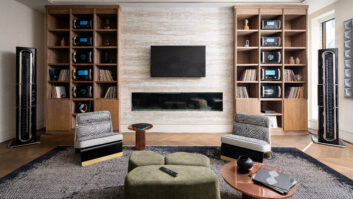DOING YOUR PART TO RETAIN A SOUND DESIGNER’S PHANTOM IMAGING
What are the most important attributes for a speaker system? Smooth frequency response and even tonal balance? Definitely.

High output capability and expansive dynamic range? Absolutely.
What about accurate phantom imaging, which is the ability of the speaker system to produce everything from pin-point discrete sounds to wide ambient effects at any point in the room? Imaging is, without doubt, among the most important attributes of a speaker system.
PURSUING REALITY
The goal of a truly enveloping and engaging sound mix is to simulate reality. In the real world, sounds can come at you from an infinite number of directions and can change direction as the sources of the sounds move. Unfortunately, even the most advanced sound systems have a finite number of speakers, and it’s impractical to move them around the room during a show.
Mix engineers have a neat trick up their sleeves, though. They can use a process called panning to adjust the relative amplitude, time, and phase of the sounds that come from each speaker. When these variations in level and time arrive at the ears of a centrally located listener, they create the illusion that sounds are coming from places where there are no speakers. Panning only works, though, if the speakers in a system are able to produce sounds that appear to come from points between or outside the speakers. This effect is called phantom imaging.
CREATING PHANTOMS 101
Speaker and listener location, arrival time, phase response, on- and off-axis frequency response, room acoustic reflections, and the overall direct-to-reflected sound energy ratio all play a role in phantom imaging.
Perhaps the

Phantom imaging only works if the speakers in a system are able to produce sounds that appear to come from points between or outside the speakers, rather than from one speaker or another.most important of these is speaker and listener location. Because human ears are on the sides of the head at (about) the same height, and most humans orient their heads in a certain way to watch a movie or listen to music, it is fairly easy to define the best places around the room for speakers to be located. Thus, we get the ubiquitous Center directly in front at 0 degrees, L/R at ±22.5-30 degrees to either side, Sl/Sr at ±90-110 degrees, and Rl/Rr at ±150- 180 degrees. While these positions and angles are a good place to start, you have to keep in mind that the boundary conditions in which a speaker is placed affect the way it images. You might position all the speakers correctly according to a diagram only to find that boundary interferences make the images pop up in all the wrong places.
Another important contributor to imaging is the arrival time, frequency response, and phase response of the direct sound from the speakers. All three of these are interrelated, and should, ideally be identical for each speaker. If the sound from one speaker arrives a little sooner than the others, it will pull the image toward it. If another speaker emphasizes mid or high frequencies a little more, it can pull the image toward it. If there are phase differences within a speaker that cause certain bands of frequencies to arrive sooner than others, imaging can completely disappear—if only over that narrow band of frequencies. Ultimately, superior imaging is achieved through a combination of good equipment and good setup.
The final component that affects imaging is room acoustics. Discrete reflections from hard surfaces can actually shift the perception of imaging by adding little virtual speakers around the room everywhere there is a reflection. The slight delay in these reflections means that they combine with the direct sound at a later time, shifting the resulting phase. This problem is compounded for speakers with wide open horizontal and vertical dispersion, especially if their off-axis response is uneven. The resulting mix of sound that arrives at your ear will be dreadful on its own and create poor images with other speakers.
The overall reflection decay time of the room impacts imaging as well, because a high level of phasey, decaying reflections can throw off the ears’ ability to detect the timing relationships of imaged sounds—especially phantom images. The ideal room will absorb or diffuse enough of the reflected sound field to achieve the correct balance of direct and reflected sound.
Chase Walton contributed to this article. BY ANTHONY GRIMANI







